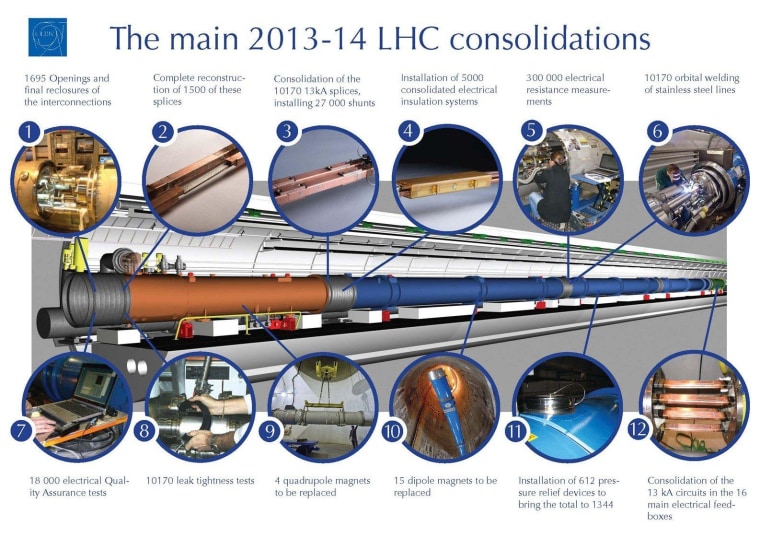After coming through with evidence for the long-sought Higgs Boson, Europe's Large Hadron Collider has begun a two-year "Long Shutdown," during which its underground components will be upgraded to run at even higher energies.
The last interacting particle beams were extracted from the machine at 7:24 a.m. Thursday Geneva time, the CERN nuclear physics center said in a news release. Most of the final beam runs were conducted with lead ions as well as protons, to study the conditions that existed in the universe just after the big bang. CERN said single-beam studies will wind down this weekend, and then the LHC's super-cooled components will be brought up to room temperature so that work can begin.
The "Long Shutdown 1," or LS1, marks the longest hiatus for the $10 billion collider since physics runs began in 2009.
"We have every reason to be very satisfied with the LHC’s first three years," CERN Director-General Rolf Heuer said. "The machine, the experiments, the computing facilities and all infrastructures behaved brilliantly, and we have a major scientific discovery in our pocket."
That discovery, announced last July, was the detection of a new subatomic particle fitting the expected characteristics of the Higgs boson, the last big piece of the puzzle for particle physics' Standard Model. The Higgs boson is thought to play a role in producing the rest mass of fundamental particles. Physicists are continuing to analyze data from the LHC's detectors and are expected to provide further details about the new "Higgs-like particle" in the weeks and months ahead.
The LHC has been running at a top energy of 4 trillion electron volts, or 4 TeV per beam, but during the Long Shutdown, the facility's magnets and connections will be checked and upgraded to the point that it can run at its maximum design energy of 7 TeV per beam, starting in 2015. Problems with the LHC's magnets and connections bedeviled the collider during its construction phase: In 2008, a faulty connection caused an explosion that delayed the start of science operations for nearly a year. That incident led CERN to take a go-slower approach to ramping up the LHC's energy.
Other parts of the facility will be upgraded during Long Shutdown 1, ranging from CERN's proton synchrotrons to the ventilation system for the LHC's 17-mile-round (27-kilometer-round) underground tunnel.

Detecting the Higgs boson was the top goal for the LHC's thousands of scientists, engineers and support personnel. During the next phase of operations, researchers hope to tease out insights about other mysteries, such as the nature of dark matter, the possibility that all subatomic particles have as-yet-unseen supersymmetric partners, and the potential existence of extra dimensions of space. So far, the LHC's research teams have reported no evidence of such exotic phenomena, but they're hoping that higher energies will reveal "new physics" beyond the Standard Model.
Scientists won't be idle during the tunnel's shutdown: CERN's mass-storage systems are hanging onto 100 quadrillion bytes of data to analyze, most of which was acquired over the past year. CERN says that amount of data is equivalent to about 700 years' worth of HD-quality movies.
"There will be plenty of physics to do during LS1, and not only at the LHC," CERN Research Director Sergio Bertolucci said. "The LHC is the flagship of CERN's experimental program, but is nevertheless just one component of a very varied research infrastructure. All of the other experiments here have ongoing analyses, so I'm looking forward to many interesting results emerging as LS1 progresses."
More about the Large Hadron Collider:
Alan Boyle is NBCNews.com's science editor. Connect with the Cosmic Log community by "liking" the log's Facebook page, following @b0yle on Twitter and adding the Cosmic Log page to your Google+ presence. To keep up with Cosmic Log as well as NBCNews.com's other stories about science and space, sign up for the Tech & Science newsletter, delivered to your email in-box every weekday. You can also check out "The Case for Pluto," my book about the controversial dwarf planet and the search for new worlds.